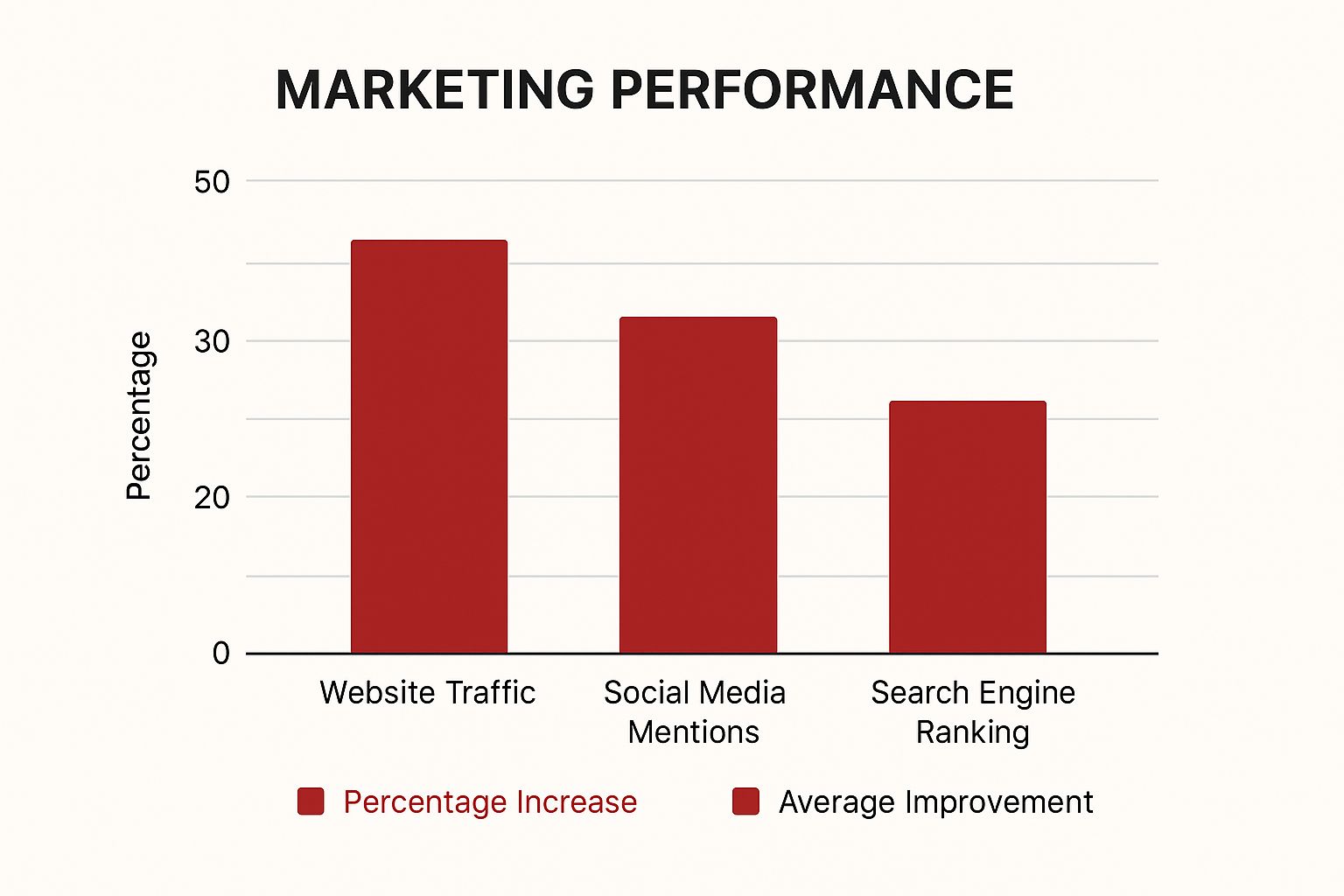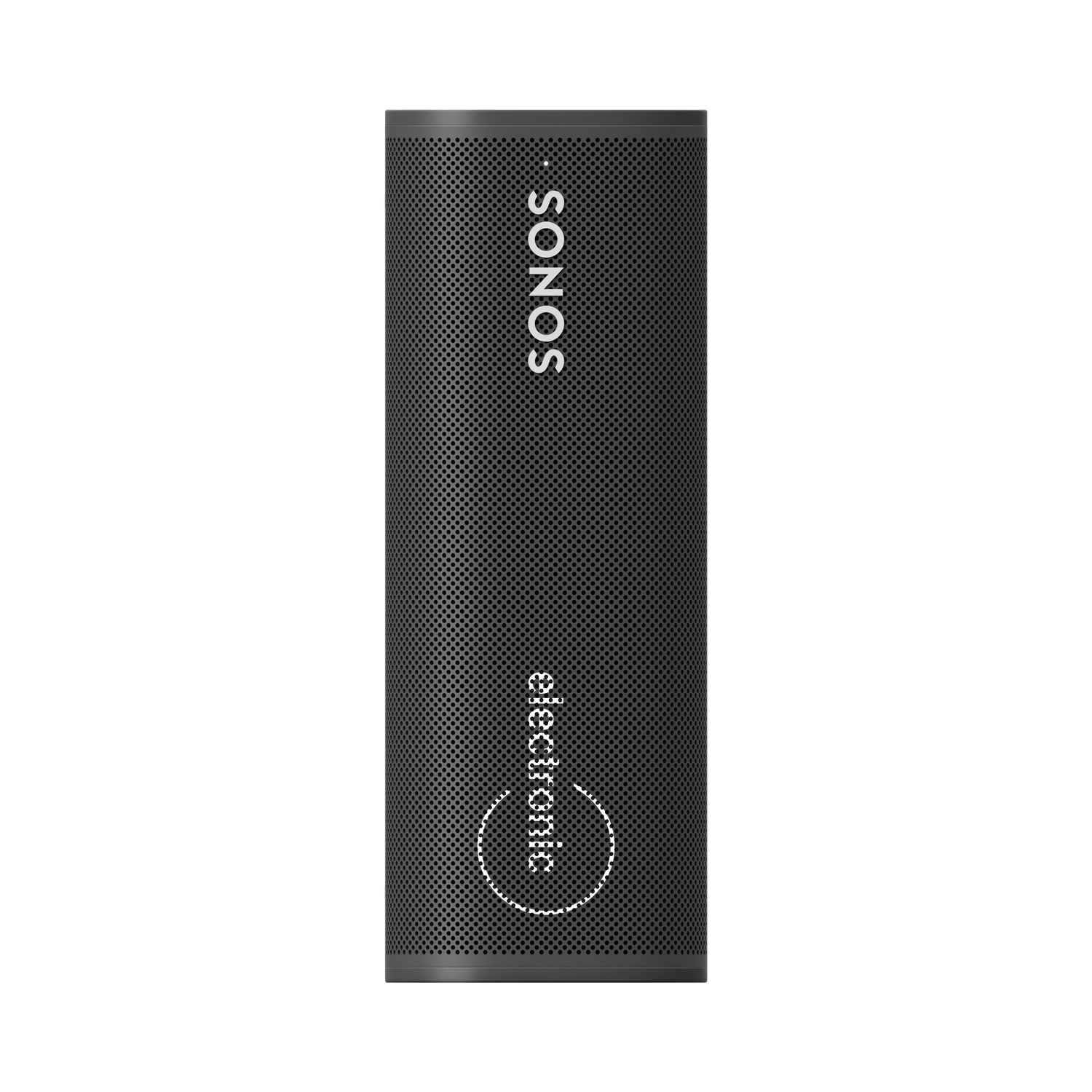The Real Impact of Brand Visibility on Business Growth

In today's crowded marketplace, a great product or service simply isn't enough. Consumers face a constant barrage of options, making it challenging for businesses to cut through the noise. This is where brand visibility becomes essential. Greater visibility leads to increased brand recognition, the crucial first step in building trust and driving sales. Imagine yourself in a grocery store aisle. Are you more likely to grab a product from a brand you know, or a completely unfamiliar one?
Most of us gravitate towards the familiar. This isn't just a hunch; it's supported by data. Brand recognition significantly influences buying decisions. Studies show that as of 2025, 50% of consumers are more inclined to purchase from recognizable brands. This highlights the importance of repeated exposure. Research indicates that brands need 6 to 7 impressions just to register with potential customers. Furthermore, 63% of customers prefer buying from brands they already know, demonstrating how consistent visibility builds loyalty. This is reinforced by the fact that 77% of consumers make purchase decisions based on the brand name itself, rather than the specific product. Find more detailed statistics here.
The Link Between Visibility and Business Metrics
Increased brand visibility doesn't just create a positive feeling; it directly impacts profitability. Higher visibility often translates to lower customer acquisition costs. If consumers are already familiar with your brand, you won't have to spend as much on advertising to introduce yourself. Strong brand visibility also boosts customer lifetime value. When customers trust your brand, they're more likely to return and even become advocates.
The Psychology of Brand Recognition
Humans are naturally drawn to familiarity. It’s a basic psychological principle. We equate familiarity with safety and trust. This inherent bias towards recognized brands provides a powerful competitive edge. This means consumers often subconsciously choose a familiar brand over a lesser-known competitor, even if the competitor's offering is similar. You might be interested in: How to master...
Quantifying the Impact of Visibility
Smart businesses understand that brand visibility is a measurable asset. They track key performance indicators (KPIs) like brand recall, share of voice, and social media engagement to evaluate the effectiveness of their visibility strategies. By analyzing these metrics, businesses can determine what's resonating with their audience, what's falling flat, and adjust their approach accordingly. This data-driven approach allows for optimization and maximizes return on investment. Ultimately, improving brand visibility is a crucial investment in long-term growth and sustained success.
Building a Visual Identity That Customers Remember

A strong visual identity is much more than just an attractive logo. It's the foundation of brand recognition, silently communicating your company's values, personality, and promises. When applied consistently, this visual language creates a lasting impression, turning quick glances into memorable brand experiences. Think about instantly recognizable brands like Apple or Nike. Their immediate recognition demonstrates the power of a well-crafted visual identity.
The Science of Visual Memorability
Building this type of instant recognition requires a deep understanding of how visual elements work together. A distinctive logo is the first step. Strategic use of color, typography, and imagery plays a critical role in shaping how consumers view your brand.
For example, using bright, vibrant colors can convey energy and innovation. A minimalist color scheme, on the other hand, might signal sophistication and elegance. These visual cues create powerful subconscious associations that influence customer perception.
Consistency: The Key to Recognition
Maintaining visual consistency across all platforms is crucial. This consistency reinforces brand recognition and builds trust with your audience. Imagine a brand with a different logo on its website, social media, and product packaging. This inconsistency is confusing and weakens brand recognition.
Consistent branding, however, builds familiarity and improves visibility. In fact, consistent brands see 3.5 times higher visibility than inconsistent ones. A consistent color palette alone can increase brand recognition by up to 80%. This highlights the significant impact of visual elements on memorability. Further reinforcing this point, 90% of consumers expect consistent brand experiences across different marketing channels. This consistency can lead to a 23% increase in revenue. For more statistics on the impact of branding, check out this resource: Branding Statistics.
To better understand the elements involved in creating a consistent visual brand, let's examine the following table:
Elements of Visual Brand Consistency This table breaks down the key components of visual brand identity and their impact on consumer recognition.
| Visual Element | Recognition Impact | Implementation Difficulty | Maintenance Requirements |
|---|---|---|---|
| Logo | High | Medium | Low |
| Color Palette | High | Low | Medium |
| Typography | Medium | Low | Low |
| Imagery | Medium | Medium | High |
This table illustrates the varying levels of impact and effort associated with each visual element. While logos offer high recognition, imagery requires more significant maintenance. Finding the right balance across these elements is key to building a strong and manageable visual identity.
Auditing Your Visual Presence
A visual audit is essential for identifying inconsistencies and areas for improvement. This involves examining every visual touchpoint, from your website and social media profiles to marketing materials and product packaging. The goal is to ensure everything aligns with your overall brand identity.
This process can uncover subtle inconsistencies that may be harming your brand recognition. Are you using slightly different shades of your brand color across platforms? Is your logo consistently sized and positioned? These seemingly small discrepancies can have a big impact on brand perception.
Evolving Without Losing Recognition
Leading brands understand that visual identity isn't static; it needs to evolve to stay relevant. But this evolution requires careful consideration. The key is to refresh your image without alienating your customer base. Think about how Google's logo has evolved over time while retaining its core elements.
Brand Guidelines: The Blueprint for Consistency
Comprehensive brand guidelines are crucial. These guidelines provide a clear framework for maintaining visual consistency across all platforms. They serve as a reference for anyone creating content or marketing materials, ensuring consistent application of the brand's visual language. These guidelines should cover everything from logo usage and color palettes to typography and image styles.
The following data chart illustrates the impact of various visual elements on brand recognition, comparing data across different platforms.
| Platform | Logo Recognition (%) | Color Palette Recognition (%) | Consistent Typography Recognition (%) |
|---|---|---|---|
| Website | 92 | 75 | 68 |
| Social Media | 85 | 62 | 55 |
| Print Materials | 95 | 80 | 72 |
| Product Packaging | 98 | 88 | 78 |
As the chart reveals, logo recognition remains consistently high across platforms, underscoring the importance of a strong, memorable logo. Color palette recognition is also important, though it fluctuates across platforms, indicating a potential need for platform-specific adjustments. Consistent typography also plays a role, although its impact is less pronounced than logo or color recognition. These findings underscore the importance of a comprehensive and consistent visual identity in maximizing brand visibility and creating lasting customer recognition.
Leveraging Authentic Influencer Partnerships That Convert

Influencer marketing offers a powerful way to boost brand visibility and connect with your target audience. It's about forging genuine connections, moving beyond simply displaying your logo everywhere. Finding influencers who truly align with your brand and resonate with your customers is key. This synergy creates authentic partnerships that transform followers into loyal customers.
This approach is increasingly important in today's marketing landscape. By 2025, the influencer marketing market is projected to reach $32.55 billion. An estimated 34% of brands are already leveraging influencer marketing to broaden their reach and raise awareness. Explore this topic further.
Identifying the Right Influencers
A successful influencer partnership begins with identifying the right individuals to represent your brand. Don't just look at vanity metrics like follower count. Instead, prioritize engagement rates, audience demographics, and the authenticity of the influencer's content.
Consider whether their values align with your brand's values. Does their audience match your target customer profile? Asking these crucial questions will help ensure a fruitful partnership.
For example, a tech startup targeting Gen Z might partner with a tech-savvy gamer on Twitch or TikTok, while a luxury brand might collaborate with a lifestyle influencer on Instagram. Platform and influencer selection are critical for effectively reaching your desired audience.
Partnership Models: Finding the Right Fit
Different visibility goals require different partnership approaches. A one-off promotion might suit a new product launch, while a long-term brand ambassadorship can nurture deeper connections and maintain visibility.
-
One-off promotions: Perfect for short-term visibility boosts and new product launches.
-
Long-term ambassadorships: Develop stronger brand association and build trust over time.
-
Affiliate marketing: Drive sales through trackable links and commission structures.
Choosing the right model depends on your specific needs and budget. Each offers unique advantages.
Measuring ROI Beyond Vanity Metrics
Measuring the true ROI of influencer marketing requires looking beyond superficial metrics like likes and shares. Track website traffic, conversion rates, and brand mentions to understand the real impact.
Use UTM parameters to track website traffic from specific influencer campaigns. Employ sentiment analysis to understand how audiences perceive your brand within the partnership. This data-driven approach provides valuable insights for optimizing future campaigns. You might be interested in: How to master...
Building Genuine Relationships
Authenticity is crucial for influencer marketing success. Building genuine relationships with influencers cultivates trust and credibility. Treat influencers as partners, not just paid promoters.
Involve them in the creative process. Provide them with creative freedom and offer valuable incentives beyond monetary compensation. This collaborative approach transforms influencers into genuine brand advocates. This results in more effective and authentic content that resonates deeply with their audience. Ultimately, strong, long-term relationships with influencers significantly boost brand visibility and drive lasting results.
Creating Content That Actually Boosts Brand Recognition
While content is frequently touted as king, much of it goes unnoticed. This section explores content types that genuinely elevate brand visibility and recognition. This isn't about simply churning out content; it's about understanding what resonates with your audience based on cross-industry performance analysis.
Developing a Content Strategy for Maximum Impact
Successful content strategies balance thought leadership and practical value. It's like a healthy diet: you need nutritious meals and the occasional dessert. Your audience needs valuable information that solves problems, but they also enjoy engaging content. This balance is key to building a loyal following.
For example, a company like Electronic Finishing Solutions (EFS) might publish a blog post about the benefits of branded tech gifts for corporate events. This provides practical value while positioning EFS as a thought leader in corporate gifting. Sharing behind-the-scenes looks at the customization process on Instagram adds engaging, human-centric content. This blend of value and entertainment maximizes reach and impact.
Creating Content That Encourages Engagement
Engaging content is like hosting a great party: offer something for everyone. This means diversifying your content formats. Experiment with a few different types of content to see what works best for your audience.
- Comprehensive guides: Offer detailed information on relevant topics.
- Short-form videos: Quickly grab attention and deliver key messages.
- Interactive quizzes: Encourage audience participation and collect valuable data.
- Infographics: Present data visually and make it easy to understand.
By diversifying content, you cater to various learning styles and preferences, boosting engagement and shares. This organic growth expands brand visibility without over-reliance on paid advertising.
Repurposing Content Across Channels
Repurposing content isn't about being lazy; it's about maximizing your efforts. A single piece of content can be transformed into various formats. A blog post could become several social media updates, a short video for YouTube, or even an infographic for Pinterest. Don't just repost the same content; adapt your message to each platform, making it feel fresh and relevant.
To understand how various content types can impact your visibility, take a look at the table below. It compares formats, resource needs, and ideal posting frequency to help you plan your content strategy.
Content Types by Visibility Impact
| Content Type | Visibility Impact | Resource Requirements | Best Platforms | Ideal Frequency |
|---|---|---|---|---|
| Blog Posts | High | Medium | Website, LinkedIn | Weekly |
| Short Videos | High | Medium | TikTok, Instagram, YouTube | 2-3 times per week |
| Infographics | Medium | High | Pinterest, LinkedIn, Website | Monthly |
| Interactive Quizzes | Medium | Low | Social Media, Website | Bi-weekly |
This table provides a general overview of content types and their potential for increased brand visibility. For more on content strategy, check out this helpful guide: How to master.... By strategically creating and repurposing content, you can build a strong online presence, enhance brand recognition, and ultimately drive business growth.
Optimizing Your Digital Presence Where It Actually Matters

True online visibility isn't about simply existing in the digital space. It's about strategically placing your brand where your target audience will see it. It's about understanding your ideal customer and tailoring your digital marketing efforts to reach them effectively.
Targeted SEO for Brand Visibility
SEO is vital for any brand looking to improve its online presence. But it's not enough to just drive traffic to your website. You need to increase brand recognition within search results. This means focusing on keywords that resonate with your brand and the audience you're trying to reach.
For example, a company like Electronic Finishing Solutions (EFS) might target keywords like "custom branded tech gifts" or "corporate gift customization." These phrases directly align with their ideal client profile of corporate marketing teams and event coordinators.
Additionally, optimizing for branded keywords is key. These are keywords that include your brand name, like "Electronic Finishing Solutions reviews" or "EFS custom AirPods." Targeting these terms helps capture users actively searching for your brand, strengthening recognition and converting awareness into leads.
Conducting a Digital Presence Audit
A digital presence audit is essential for understanding your online strengths and weaknesses. Think of it as a checkup for your brand's visibility. It helps identify gaps and opportunities across various platforms, including search engines, social media, and review sites.
This audit should address key questions: Where do your competitors excel? Are there platforms your target audience frequents where your brand is absent? Answering these questions can pinpoint areas for improvement. Perhaps your brand thrives on LinkedIn but lacks presence on Instagram, a platform where your target audience is highly engaged.
User Experience: Creating Memorable Interactions
User experience plays a significant role in brand visibility. A positive experience creates a lasting impression and encourages repeat engagement. This means ensuring your website is easy to navigate, your app interface reflects your brand personality, and your content is engaging and easy to understand.
EFS, for instance, might focus on streamlining the online ordering process for their custom tech gifts. Intuitive product customization options and clear pricing information enhance the user experience and strengthen positive brand perception. Read also: How to master...
Digital Advertising for Recognition
Digital advertising campaigns can boost brand recognition. This involves focusing on creative content that reinforces your brand identity and key messages, rather than solely prioritizing clicks. Think of memorable Super Bowl ads that generate buzz even among viewers who don't immediately buy the product. For EFS, this might involve visually compelling ads showcasing their custom-branded products on platforms like LinkedIn and Instagram, targeting their specific client demographic.
Analytics: Refining Your Visibility Strategy
Data analysis is critical for optimizing your brand visibility strategy. Instead of focusing on vanity metrics like likes and followers, prioritize metrics that reflect genuine engagement and brand lift. This includes tracking brand mentions, share of voice, and website traffic originating from branded searches.
These insights allow you to refine your approach and demonstrate the ROI of your visibility efforts. You might discover that certain campaign elements resonate more effectively with your audience, leading to increased brand recall. This knowledge allows for smarter resource allocation. By consistently analyzing data and adapting your strategy, you ensure continued growth in brand visibility and maximize the impact of your digital presence.
Building Strategic Partnerships That Amplify Your Reach
Beyond influencer collaborations, strategic partnerships offer a powerful way to boost your brand’s visibility. Teaming up with other businesses allows you to access their established audiences and significantly expand your own reach. This collaborative approach can lead to impressive visibility gains, especially for smaller brands looking to grow their recognition.
Exploring Partnership Models for Visibility Gains
Several partnership models can effectively increase your brand’s visibility. Each offers unique advantages and aligns with different visibility goals.
-
Co-branded Products: Developing a product in conjunction with another brand introduces both audiences to each other. For example, a clothing company could partner with a shoe brand to create a limited-edition outfit. This generates excitement and interest among both customer bases.
-
Cross-Promotions: This involves promoting each other's offerings to your respective audiences. Something as simple as featuring each other in email newsletters or running joint social media contests can be highly effective.
-
Collaborative Content: Creating content together, such as webinars, blog posts, or videos, exposes your brand to a broader audience. Simultaneously, it provides valuable information to potential customers.
The best partnership model depends on your target audience, industry, and specific visibility goals.
Identifying the Right Partners: Shared Values and Complementary Audiences
Successful brand partnerships hinge on choosing partners whose values align with your own and whose audiences complement, rather than compete with, yours. This synergy maximizes benefits for everyone involved. Think of it like two puzzle pieces fitting perfectly together to create a more complete picture.
For instance, Electronic Finishing Solutions (EFS), specializing in custom branded tech gifts, could partner with a corporate event planning company. They share a target audience of corporate marketing teams. This creates a valuable cross-promotional opportunity that benefits both brands.
Initiating and Structuring Successful Partnerships
Starting a partnership conversation requires a clear understanding of your contributions and what you hope to gain from the partnership. This collaborative approach ensures a mutually beneficial relationship.
Formal agreements outlining each partner's responsibilities, marketing efforts, and expected outcomes are essential. Clear communication and agreed-upon metrics prevent misunderstandings and set the stage for a productive partnership.
Learning From Case Studies: Successes and Pitfalls
Examining real-world examples of both successful and unsuccessful brand partnerships offers valuable insights. Learning from others' experiences helps you navigate potential challenges and maximize the positive impact on your brand’s visibility.
A smaller tech startup, for example, might partner with a larger, more established tech company to offer a bundled product or service. This significantly expands the startup’s reach and introduces its brand to a larger audience.
However, issues like poor communication or mismatched brand values can derail collaborative efforts. Analyzing these potential challenges helps you avoid common mistakes. By strategically selecting partners and developing clear agreements, even small brands can leverage partnerships to significantly improve their visibility and build a stronger market presence.
Measuring What Matters: Tracking Brand Visibility Success
Improving brand visibility is an ongoing effort. To understand what strategies are effective and what needs tweaking, you need to measure your progress. This requires moving beyond superficial metrics like follower counts and likes, which can be deceptive. Instead, focus on establishing meaningful key performance indicators (KPIs) that directly reflect your brand's visibility and contribute to your business objectives.
KPIs That Actually Matter
Several KPIs provide valuable insights into your brand visibility initiatives:
-
Brand Recall: This measures how readily consumers remember your brand when thinking about a specific product category. For example, if someone mentions "athletic wear," does your brand come to mind? Strong brand recall indicates effective visibility.
-
Sentiment Analysis: This assesses public opinion about your brand by analyzing online discussions and reviews. Positive sentiment strengthens brand trust and contributes to sustained visibility.
-
Share of Voice: This metric compares your brand's online presence to that of your competitors. A larger share of voice suggests greater visibility within your industry.
-
Attribution Modeling: This determines which marketing channels are most successful in driving brand awareness and conversions. Understanding these touchpoints helps optimize resource allocation.
Setting Up a Measurement Framework
Creating a practical measurement framework involves choosing the right tools and establishing reasonable benchmarks.
-
Social Listening Tools: These tools, like Brand24, monitor brand mentions, hashtags, and industry conversations, offering valuable data on public perception and competitor activity.
-
Customer Surveys: These provide direct feedback from your target audience, giving a deeper understanding of brand recall and overall satisfaction. Tools like SurveyMonkey can be helpful for this.
-
Website Analytics: Analyzing website traffic, bounce rates, and time spent on page reveals how well your online presence attracts and engages potential customers. Google Analytics is a popular tool for this.
Establishing Realistic Benchmarks
Your industry, available resources, and specific goals should all influence your visibility benchmarks. Avoid comparing your startup's metrics to those of a large, established company. Instead, prioritize measurable progress over time.
-
Industry Benchmarks: Research typical visibility metrics within your industry to understand what constitutes strong performance.
-
Historical Data: Track your brand's visibility metrics over time to identify trends and assess improvement.
-
Competitor Analysis: Analyze your competitors' visibility strategies to discover opportunities to surpass them.
Using Data to Refine Your Strategy
The data collected should inform your ongoing visibility strategy. If social listening reveals negative sentiment around a recent product launch, address the concerns promptly. If attribution modeling shows that a particular marketing channel isn't delivering results, reallocate resources to more effective channels. By consistently analyzing data and adjusting your approach, you ensure your brand visibility efforts yield tangible business outcomes. This data-driven methodology also allows you to demonstrate a clear return on investment (ROI) to stakeholders, justifying continued investment in your brand visibility strategies.
Ready to boost your brand visibility with high-quality, custom-branded tech gifts? Visit Electronic Finishing Solutions today to explore our range of customizable products and learn how we can help your brand stand out.



